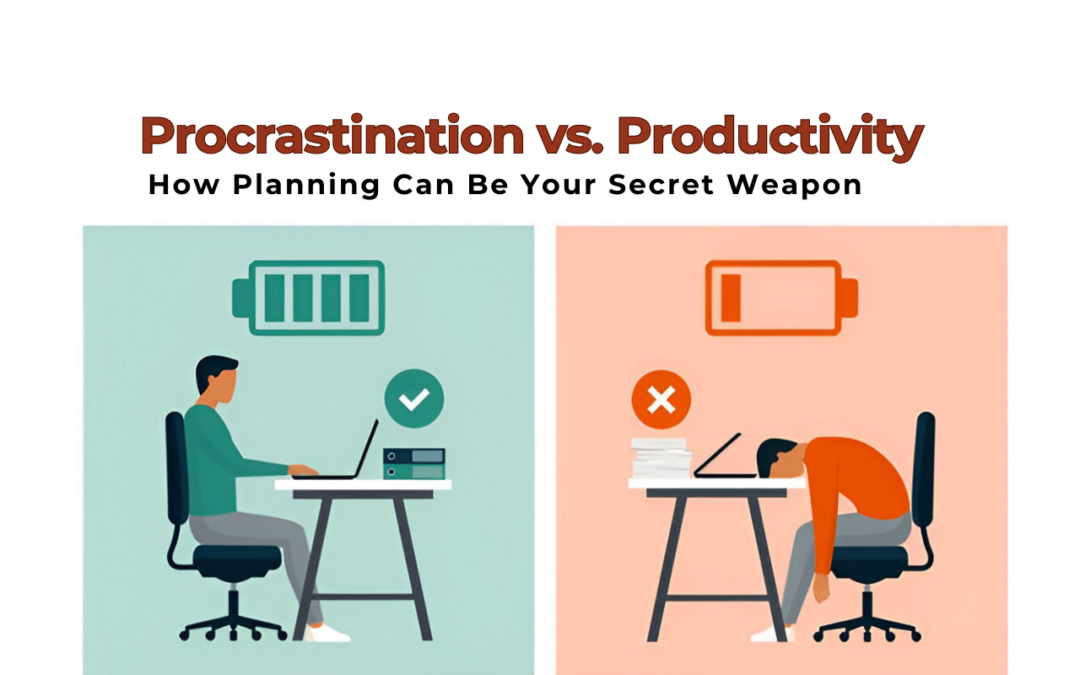Visualise a busy working professional surrounded by an almost endless growing stack of tasks and projects to complete—their inbox overflows with unread emails, each clamouring for attention. A critical deadline looms tomorrow, yet they find themselves reorganising their desk—an activity that suddenly feels urgent. This situation can play out in countless lives, and it really highlights the pervasive challenge of procrastination and the devastating impact that a lack of Time Management can have on daily work schedules.
Understanding Procrastination and Its Roots
People often think procrastination is just about delaying tasks. It isn’t. It is a habit that often brings stress, guilt, and missed opportunities for those working professionals who are plagued by this on a day-to-day basis. It’s not just a lack of discipline; the root cause is driven by complex psychological factors, and there is an assortment of triggers to be aware of. One major trigger is the fear of failure. When people worry about not measuring up, they may avoid starting tasks altogether, haunted by past mistakes or self-doubt. Imagine the case of a worker who once submitted a flawed report; they might hesitate on a new assignment, fearing a repeat of this episode. They might remember very clearly the criticism they endured when they missed the mark, and this fear can trap them in a cycle of avoidance, making action feel riskier than inaction.
Another culprit is perfectionism. Those who demand flawless results often delay starting unless every detail is ideal. They set impossibly high standards, believing that anything less isn’t worth attempting. A writer, for instance, might stall on a novel, waiting for the perfect opening line that never comes. This pursuit can also lead to overplanning—spending so much time preparing that execution never begins.
This feeling of being overwhelmed can frequently stall a worker’s progress and momentum and affect their efficiency and effectiveness. Without clear priorities, every task feels equally pressing, which can amplify the paralysis and delay action. Distractions worsen this situation even more, as today’s digital world bombards us with notifications, social media, and endless entertainment. When a worker glances at a ping notification, this can lead them down a slippery path, and that 10-second glance stretches into an hour lost, and even planned breaks derail without firm limits being put in place.
Overcommitment adds another layer. Many people struggle to say no, piling their schedules with work, friends, or family obligations. A packed calendar leaves little room for personal goals, stretching them thin. Then there’s decision fatigue: each choice—whether about a task or dinner—drains mental energy. Even small decisions feel exhausting by evening, let alone tackling a big project.
Procrastination’s toll extends beyond delays. Research shows chronic procrastinators face higher stress, anxiety, and depression. The guilt of not completing assignments or tasks often feeds a negative loop in the minds of these workers, making action even harder in the future.
Planning: The Antidote to Procrastination
Planning offers a powerful countermeasure and panacea to procrastination. By organising tasks, setting priorities, and breaking projects into smaller steps, it reduces the mental barriers that fuel delay. This approach makes day-to-day work feel less intimidating and stressful and more approachable, restoring a sense of control that lifts spirits and can bring heightened job satisfaction.
For those fearing failure, planning creates small, achievable milestones. Completing each step builds confidence, softening the anxiety of the bigger goal. A new marketing intern dreading a presentation might start by outlining key points, then drafting slides—each success easing their worry. Perfectionists benefit from realistic timelines that value progress over perfection. Setting a goal to write 500 words daily, rather than a flawless chapter, shifts focus to steady effort.
When overwhelmed hits, planning provides a clear starting point and a logical sequence, turning a chaotic workload into manageable chunks. Distractions weaken under a plan that carves out focused work periods—silencing notifications or using techniques like the Pomodoro method (25-minute work bursts with short breaks). Overcommitment becomes manageable as a planned schedule reveals capacity limits, empowering people to decline less critical requests. Pre-made decisions—like scheduling meals or workouts—also preserve mental energy for priorities.
Putting Planning into Practice
Let’s explore how planning works across different lives:
- A Student: Facing a research paper deadline, an unplanned student might waste days and then cram in a panic. With a plan, they’d allocate time for research (Monday), drafting (Tuesday-Wednesday), and editing (Thursday), spreading effort over a week. This reduces stress and improves quality. Tools like a to-do list for daily tasks or a calendar for deadlines keep them on track.
- A Freelancer: Managing multiple clients, an unplanned freelancer might bounce between tasks, losing focus. A plan assigns specific hours—say, Client A in the mornings, Client B in the afternoons—ensuring steady progress. Batching similar tasks (e.g., all emails on Friday) boosts efficiency.
- A Parent: An unplanned parent might feel pulled in every direction by juggling work and home. A plan schedules work during school hours, reserves evenings for family, and plans chores weekly. This balance protects personal time and reduces chaos.
Tools enhance planning’s impact:
- Digital Calendars: Synced across devices, they streamline scheduling with reminders—like Google Calendar.
- Project Management Apps: Tools like Trello or Asana use vision boards to track complex tasks.
- Pen and Paper: A notebook or planner suits those who prefer simplicity, offering flexibility without tech distractions.
The best tool syncs with the user’s life, so a busy parent might love an app for on-the-go updates, while a student might thrive with a physical planner that focuses on tactile feelings. Experimentation helps find the right fit.
The Transformative Power of Planning
Approaching tasks can be completely transformed when people master the art of effective planning and see the real benefits for themselves because it cuts the stress and regret that procrastination breeds, boosting productivity and goal achievement. Spending just 10 minutes daily mapping out priorities reclaims control over time and commitments. Over subsequent weeks and months, this habit, which solidifies incrementally, boosts a proactive mindset.
Beyond efficiency, planning lifts well-being. Completing tasks lowers stress and sparks satisfaction—each checkmark a small victory. Confidence grows, too; seeing plans succeed builds belief in one’s ability to manage life. In fact, a 2019 study found that regular planners reported 30% less stress than non-planners.
Planning isn’t an instant remedy in itself. Like all things in life, becoming a master it takes time to hone this critcial skill. Start small: plan one task daily, like a workout or email check. Gradually expand—add a weekly schedule, then monthly goals. Setbacks happen but should be internally labelled as lessons, not failures.
Conclusion: From Procrastination to Progress
Procrastination, with its deep psychological roots in fear, perfectionism, and being overwhelmed, traps many in a cycle of delay and distress. Yet, it’s not unbeatable. Planning breaks this cycle by simplifying tasks, clarifying priorities, and restoring control.
Adopting a planning mindset and spending just 10 minutes a day to map out your top priorities and what success looks like takes minimal time but yields lasting rewards: less stress, more output, and a stronger sense of self. Digital or analogue tools amplify its power, tailored to individual needs. As a learnable skill, planning invites patience; small steps build to significant changes. This mindset shift from procrastination to productivity begins with one choice. To plan or not to plan – this is the ultimate question!












